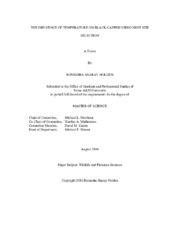| dc.description.abstract | For avian species in breeding habitats, reproductive success is highly influenced by nest site selection, and changes in the physical environment can drive small-scale changes in individual behavioral responses that influence the nest site selection process. Guthery’s (1997) useable space hypothesis combines principles of habitat selection and habitat use, while considering habitat structures and environmental fluctuations, to evaluate the influence these changes have on avian behavior and reproductive success over time. From March to July of the 2013 and 2014 black-capped vireo-breeding seasons at Kerr Wildlife Management Area (KWMA) in Kerr County Texas, I examined the influence of temperature on vireo nest site selection to test Guthery’s useable space hypothesis with relation to changes in nest sites and ambient temperature. I measured temperature in vireo breeding habitat at KWMA to determine the influence of vegetation characteristics on ambient temperature across sites. I compared vegetation measurements across the site to vegetation measured at nest sites specifically to determine differences in used versus available areas. I then investigated whether vireos change nest site characteristics over the course of the breeding season to finally evaluate if in fact temperature influenced vireo nest site selection. As expected, temperature increased over the course of the breeding season from April to July. In addition, vireos also chose nest sites with different vegetation characteristics in relation to time of season. As the useable space hypothesis is stated, changes in an organism's needs should be supported in their respective habitats. Vireos used areas of habitat with higher percent shrub cover at nest sites than at temperature data logger’s site location measurements. Though I did not find a difference in temperature within areas of different vegetation characteristics, I did not measure temperature at nest site locations; therefore, there could still be some thermal preferences for vireos at nest sites. | en |


